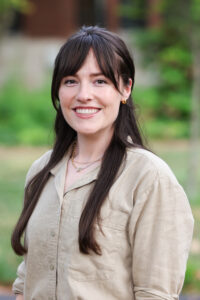Currently in Darmstadt, Germany, MSMP student Hannah York is working to advance research in radiation therapy for pediatric brain cancer patients with the support of her VUSM community.
By Kyra Letsinger

In the spring semester of her first year, Master of Science in Medical Physics student Hannah York was at a crossroads. Before her was the opportunity of a lifetime, a chance to work on radiation oncology research at the GSI Helmholtz Centre for Heavy Ion Research (GSI) in Darmstadt, Germany. She was ecstatic at the prospect, and it seemed to check all her boxes: an incredible research mentor in VUSM Professor of Radiology Oncology John Eley Ph.D., a topic she deeply cared about, and a fantastic lab team to collaborate with. Though everything was seemingly falling into place, York still felt slight hesitation. If she took the opportunity, she would miss the summer MSMP courses and, in turn, graduate a semester later than her peers. She needed an outside opinion and turned to one of the wisest, most intuitive people she knew, Vanderbilt Director of Clinical Medical Physics Robert Rodgers, MS, who immediately got the no-nonsense answer she was looking for.
“Colonel Rodgers looked at me and asked what I could possibly mean by the opportunity ‘putting me behind,’” said York. “I explained that I would graduate later, and he asked if I was on some important deadline. I was not. He reminded me that doing things on a ‘timeline’ at the cost of a valuable and unique experience would not be worth it in twenty years when I’m looking back on my life. I couldn’t argue with that!”
This type of no-questions-asked support from the leaders of the Vanderbilt MSMP program has been a much-appreciated constant for York throughout her first year, whether in the form of Colonel Rodgers’ blunt advice or Dr. Eley’s excited encouragement. She says both skillsets have led the two to become pivotal mentors during her time at Vanderbilt.

“Col. Rodgers can gauge a room in an instant and is perhaps the most intuitive and calculating person I’ve ever met,” said York. “Dr. Eley, on the other hand, is the most encouraging instructor I’ve ever had, almost to a fault. If I told him I wanted to figure out how to create a wormhole and travel through time he would be pumped and tell me to absolutely go do it! He also holds me accountable and loves to go down physics rabbit-hole topics that are on my mind with the best explanations.”
Despite their differing support styles, both professors agreed that York would excel in this research opportunity and were determined to give her the final push to say ‘yes.’ If there was anyone who could convince her, it was the members of the VUSM community who had helped her find her passion for medical physics in the first place.
Finding the Right Path and a Close-Knit Community
A 2022 graduate of the University of Alabama at Birmingham (UAB) with a degree in Biophysics, York began her higher education journey as a pre-med student interested in becoming a physician. To her surprise, she started feeling a lack of connection to what she was learning in her pre-med courses and began looking at different options, even considering leaving the medical field altogether to pursue law. Only when she learned about medical physics, a field she was unfamiliar with, from a UAB health physicist would she find her true calling. As fate would have it, she would soon have the chance to talk to two field experts that would seal the deal: Vanderbilt Medical Physics’ Dr. Eley and retired Associate Professor of Radiology and Radiological Sciences, David Pickens III, PhD, DABR, FAAPM.
“I looked into [medical physics] schools and courses and actually met with the [Vanderbilt MSMP] program director, my now mentor Dr. Eley, as well as Dr. David Pickens, a man who helped build our program into what is it today but has since retired, said York. “I think it was when I was meeting with Dr. Pickens that I really felt that I had finally found a perfect career match at the intersection of medicine and physics.”
When considering where to further her education, York knew she wanted to train in the southeast so she could eventually serve those who have less access to advanced radiological treatment options. This desire to help the underserved, accompanied by her inspiring discussions with Vanderbilt MSMP educators, confirmed Vanderbilt was the perfect place to pursue her degree.

“During the interview, I was blown away; there was really no other place that compared in terms of the level of personability and genuine passion the faculty had for teaching for understanding.”
York’s experience in her first year far exceeded her already high expectations. Academically, she thrived, working closely with her professors to explore her field interests and deep-diving into her chosen track of radiation therapy. Potentially the most enjoyable aspect of the program, though, came as a bit of a surprise, in the form of support and comradery from her peers.
“One thing that is never a guarantee with any program, much less one as nerdy as this one, is the other students, but learning with all of them has been perhaps my favorite part,” York said. “All five of us see things very differently, but we lean on each other and take turns explaining things and meeting up to study and quiz each other. It’s been a very unexpected and enjoyable part of the program.”
Through the consistent support of her professors and peers, York completed her first year confident in her abilities and ready for the next chapter; she was ready to travel to Germany and take full advantage of the unique research opportunity in front of her.
Conducting Research to Save the Vulnerable

Arriving in Darmstadt in early May, York was eager to begin research on pediatric high-grade gliomas (pHGG), an extremely aggressive and radioresistant form of pediatric cancer. The topic is one near and dear to her heart as she saw first-hand the heart-wrenching impact the disease had on one of her own friends back in Huntsville.
“One of the boys I grew up with at home passed away from a pHGG my freshmen year of college, and I will never forget visiting him at the hospital and seeing the havoc that the disease was wreaking upon his mind and body,” York said. “I can’t imagine what his parents were going through, much less how he handled things as well as he did, so anything I can do to contribute to giving someone like that more time with their family and loved ones, I will consider a huge achievement.”
PHGG is known for its notoriously poor prognosis, with less than 20% of patients living beyond five years of treatment and most only living 11-14 months. This high mortality rate stems from the limitations of current treatment modalities. Surgical resection is unable to remove microscopic disease from the brain and chemotherapy is often unsuccessful due to the blood-brain barrier. Anothertreatment option is photon or proton radiation therapy, but still, they are often too broad and leave healthy brain tissue at risk of being affected. York says the future of this treatment lies in the far more exact abilities of carbon ion radiation therapy (CIRT), especially for tumors that are unable to be resected.
Unfortunately, while CIRT has been successfully implemented in Japan and Germany, the treatment has yet to be adopted in the United States due to insufficient data on High Linear Energy Transfer (LET), which quantifies the amount of energy used to target a tumor. This lack of information is where York hopes her research can make an impact aiming to bridge the knowledge gap, support the efforts of organizations like the Mayo Clinic in accelerating U.S. adoption of CIRT, and advance the field of radiation oncology by providing more effective treatment options for pHGGs.
“My research aims to address this gap by developing a comprehensive dose and LET map for Carbon-12 in water, refining dose calculations in a mouse brain model, and conducting experimental validations at the NASA Space Radiation Laboratory at the Brookhaven Laboratory in New York,” said York. “The central hypothesis posits that the LET map can accurately predict the in vivo response of central nervous system tissue to CIRT, thus optimizing treatment protocols.”

From independently exploring topics and materials out of sheer curiosity to collaborating with experts equally passionate about the field, York has found personal and professional inspiration in every aspect of her work abroad.
“I think international collaboration is key to advancing the field of medical physics,” York said. “Due to most of Europe having socialized medicine, there is more funding for innovation but usually on more of a trial-and-error basis. In the U.S. we are much slower to adopt innovations, but when we do, they are backed by robust science. Both are needed to advance the field, and I am thrilled to be a part of such an effort.”
Above all, York is grateful for the way the opportunity has allowed her to grow as a physicist-in-training. She looks forward to applying what she’s learned to her studies and, of course, sharing it all with her MSMP family when she returns to Vanderbilt this fall.